Daniel Sherrier's Blog, page 42
May 25, 2016
Today’s Super Comic: Hawkeye #22 (2015)
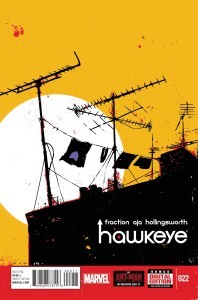 I was blown away when I read the first trade paperback of this Hawkeye series. Now that I’ve read the final issue at long last, I can officially say that, yes, they keep the quality high right up until the finish line.
I was blown away when I read the first trade paperback of this Hawkeye series. Now that I’ve read the final issue at long last, I can officially say that, yes, they keep the quality high right up until the finish line.
If you’re wondering how Hawkeye can possibly carry his own series, the answer is “with phenomenal, innovative execution.” Also, having two Hawkeyes helps. Clint Barton is the Hawkeye moviegoers will recognize, but there’s also Kate Bishop, who became the second Hawkeye while Clint was dead for a little while several years ago. Both are likeable, relatable characters who are far from perfect but keep pushing on until they get the job done. And the interplay between the two never fails to entertain.
The series focuses on the trouble Hawkeye and Hawkeye get into when they’re not with the Avengers or embroiled in any sort of big operatic superhero action. That’s a simple but very smart approach. The book gets to play within a wonderful fictional landscape, but it’s free from ever getting tangled up in the big events of the broader Marvel Universe, leaving it accessible to casual readers.
Great writing by Matt Fraction. Great art by David Aja that capitalizes on the storytelling possibilities the comic book format offers. Great sense of humor. An overall great time from start to finish.
Of course, this issue is the end, so don’t start here. This is merely confirmation that the series never suffered a creative slump. So go back to #1 and read every issue. Hawkeye is an achievement that should inspire all of us creative sorts to aim a little higher.
Writer: Matt Fraction
Artist: David Aja
Publisher: Marvel Comics
How to Read It: recent back issues; Marvel Unlimited; included in Hawkeye vol. 4: Rio Bravo (TPB)
Appropriate For: ages 15 and up
May 24, 2016
Today’s Super Comic: Flash #91 (1994)
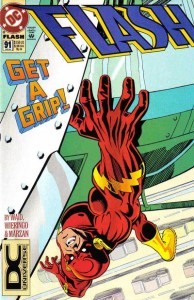 I’ve been a Flash fan since I was nine years old. Mark Waid’s stories in the early to mid-1990s greatly contributed to hooking me on comics for life.
I’ve been a Flash fan since I was nine years old. Mark Waid’s stories in the early to mid-1990s greatly contributed to hooking me on comics for life.
So, in honor of tonight’s season finale of the CW’s often-fun Flash television series, let’s look at one of the many excellent issues from Waid’s run on the title. (People like to announce whether they intend their puns or not. I’ll let it remain a mystery for the ages.)
A recurring plot on the TV show this season has involved the Flash trying to increase his speed. In Flash #91, we see what happens when he succeeds in achieving a major boost.
This Flash isn’t Barry Allen, though. This is Wally West. I’m not spoiling anything because it was the status quo for many years, but Barry died long before this and his nephew (related through his wife Iris) graduated from being Kid Flash to the Flash. And at first, Wally was a far cry from the heroism of Barry Allen. Wally was a self-centered jerk early in post-sidekick tenure, but Waid’s stories focused on his gradual maturation.
Because of events from recent issues, Wally is determined to save everyone. No one can die because he was busy saving someone else. But when faced with the dilemma of needing to prioritize who to rescue, he employs Johnny Quick’s speed formula to enhance his powers…and winds up stuck at near-lightspeed, in a city that’s basically frozen to him.
Can the fastest man alive be everywhere at once? Really, can any of us do everything we feel we need to do? It’s a simple but surprisingly mature dilemma for the Flash, and Waid addresses it without resorting to any cynicism whatsoever. Whether you’re an adult or a kid, this is a fantastic short story that builds on what came before and tees up future plotlines.
Writer: Mark Waid
Penciler: Mike Wieringo
Inker: Joe Marzan Jr.
Publisher: DC Comics
How to Read It: back issues
Appropriate For: ages 9 and up
May 23, 2016
Today’s Super Comic: Doctor Strange #2 (2015)
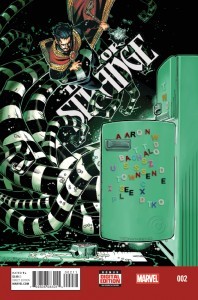 I’ve never been much of a Doctor Strange fan. I’ve liked him as an occasional guest star throughout the Marvel Universe, but I’ve never gotten into his solo series.
I’ve never been much of a Doctor Strange fan. I’ve liked him as an occasional guest star throughout the Marvel Universe, but I’ve never gotten into his solo series.
But this latest attempt at series has me interested so far. (And by “so far,” I mean the two issues that are available on Marvel Unlimited as of this writing.)
The second issue takes us on a tour through Doctor Strange’s highly dangerous home/headquarters, the Sanctum Sanctorum, which allows artist Chris Bachalo a chance to shine. Bachalo has always specialized in unconventional layouts, in which the panels seamlessly bleed into each other and strange creatures run amok wherever they please, so he’s a natural fit for the Sorcerer Supreme’s weird magical world. Here, he gives each surreal room in the Sanctum Sanctorum its own brand of crazy, resulting in a comic that never lacks for visual appeal.
Writer Jason Aaron’s take on the character seems to be that Doctor Strange is New York’s weirdest doctor, in that he’s the guy who treats supernatural maladies that afflict ordinary people. (How this compares to previous writers’ takes on the character, I haven’t read enough to say.) His “patient” in this issue is a librarian from the Bronx who has creepy mouths growing on the top of her head. Not the sort of thing a conventional hospital can treat.
This issue is mostly just laying a foundation for future stories, but I’m curious to read more. And that’s a sign of a successfully executed comic.
Writer: Jason Aaron
Penciler: Chris Bachalo
Inker: Tim Townsend, Al Vey, and Mark Irwin
Publisher: Marvel
How to Read It: recent back issues; Marvel Unlimited; included in Doctor Strange Vol. 1: The Way of the Weird (HC)
Appropriate For: ages 13 and up
May 22, 2016
Today’s Super Comics: Detective Comics #475-476 (1978)
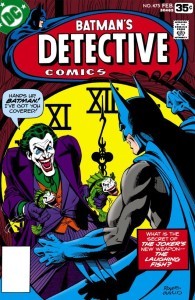 Writer Steve Englehart and artist Marshall Rogers had a superb and all-too-brief run of Batman stories in Detective Comics in the late 1970s, climaxing in this two-part Joker tale. It’s so good, Batman: The Animated Series adapted it pretty faithfully years later.
Writer Steve Englehart and artist Marshall Rogers had a superb and all-too-brief run of Batman stories in Detective Comics in the late 1970s, climaxing in this two-part Joker tale. It’s so good, Batman: The Animated Series adapted it pretty faithfully years later.
The Joker wants to copyright fish. He poisons them so that they all have permanently grinning faces, thus sharing his likeness. So he feels his copyright claim is a perfectly reasonable proposition, and until he gets his cut of every fish sale nationwide, he’ll kill one person at a time. Each execution is publicly announced, with plenty of forewarning for Batman and the police to take measures to protect the innocent…provided they can predict how their brilliantly insane nemesis will strike.
And then there’s the ongoing subplot of Bruce Wayne’s new love interest, Silver St. Cloud—an excellent match for him and someone too smart to be fooled by a mask.
There are a lot of great interpretations of Batman out there, in print and in film, but this is the type of Batman I prefer. He’s heroic, intelligent, strong, and not crazy. This Batman is capable of warmth and healthy relationships, while still being driven and utterly devoted to his mission.
The depiction of the Joker is also spot-on. He’s frightening in his unpredictability, but with an underlying method to his madness that can be fathomed only by himself.
There are no cheap shocks here, just strong storytelling skills, great characters, and an inventive story.
Writer: Steve Englehart
Penciler: Marshall Rogers
Inker: Terry Austin
Publisher: DC
How to Read Them: back issues; included in Batman: Strange Apparitions (TPB)
Appropriate For: ages 10 and up
May 21, 2016
Today’s Super Comics: Daredevil #227-233 (1986)
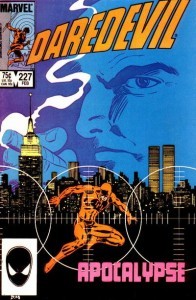 Frank Miller has written some great comics over the years…and some that, well, simply aren’t eligible for this series of only positive comics reviews.
Frank Miller has written some great comics over the years…and some that, well, simply aren’t eligible for this series of only positive comics reviews.
But when he’s on, he’s one of the best in the business. And this Daredevil storyline, Born Again, is Miller at his best, producing one of the greatest comic book storylines ever to grace the newsstands—especially with the excellent work of artist David Mazzuchelli that perfectly fits the gritty world of Hell’s Kitchen.
The idea is simple: Daredevil’s ex-girlfriend Karen Page sells his secret identity for drug money. This information finds its way to the Kingpin, who then uses it to ruin Matt Murdock’s life. And things had already been going rather lousy for Matt in the preceding issues.
Writers are generally supposed to make characters’ lives hell, and yeah, Miller seems to have received that memo. Daredevil gets broken down so he can build himself back up. Events strip him to his essence, allowing us to see what kind of man he truly is.
And DD isn’t the only one in crisis. Karen is on the run, and Daily Bugle journalist Ben Urich gets in over his head while trying to investigate the Kingpin. Seven issues of nonstop momentum—tense and gripping the whole way.
If you’ve enjoyed Daredevil’s Netflix series, you’ll definitely want to check these issues out.
Writer: Frank Miller
Artist: David Mazzuchelli
Publisher: Marvel
How to Read It: back issues, Marvel Unlimited, Daredevil: Born Again (TPB)
Appropriate For: ages 15 and up
May 20, 2016
Today’s Super Comic: Ms. Marvel #6 (2014)
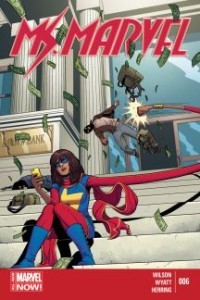 Marvel Comics made lots of headlines when the new Ms. Marvel was announced, as the series features the company’s first Muslim superhero. That’s nice, but it would’ve been meaningless if the book wasn’t any good.
Marvel Comics made lots of headlines when the new Ms. Marvel was announced, as the series features the company’s first Muslim superhero. That’s nice, but it would’ve been meaningless if the book wasn’t any good.
Now that I’ve finally gotten around to checking out the first six issues, I’m happy to say it’s great. This book is ridiculously fun.
Kamala Khan is an Avengers fangirl turned superhero, and this Jersey City teenager is still getting the hang of her new powers as the second storyline begins. She’s very likable, and as an outsider who’s just trying to do the right thing, she fits the classic wish-fulfillment trope the superhero genre often excels at. And her stretchy/shrinky powers are not only visually interesting, but they suit the awkwardness of the teenage years.
Of course, every superhero needs a great nemesis, so Ms. Marvel gets…Thomas Edison…a genetically engineered bird-man named Thomas Edison. It’s kind of perfect, actually.
And she gets her first superhero team-up in this issue, and the interaction between the two is nothing short of delightful. She’s enjoying every second of it, and therefore the reader is, too.
More comics need to be like this. It’s great for middle school readers and still plenty of fun for adults.
Writer: G. Willow Wilson
Artist: Jacob Wyatt
Publisher: Marvel Comics
How to Read It: back issues, Marvel Unlimited, Ms. Marvel vol. 2: Generation Why (TPB)
Appropriate For: ages 11 and up
May 19, 2016
Today’s Super Comic: Action Comics #761 (2000)
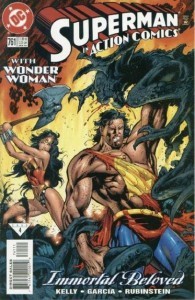 Superman and Wonder Woman meet Thor! Okay, not Marvel’s Thor, but Norse mythology happens to lie within the public domain, so they can get transported to Valhalla and meet a different interpretation of Thor.
Superman and Wonder Woman meet Thor! Okay, not Marvel’s Thor, but Norse mythology happens to lie within the public domain, so they can get transported to Valhalla and meet a different interpretation of Thor.
But that’s actually the least of what makes this single-issue story so fantastic. It opens amid an ongoing subplot at the time in which the public suspects there might be a “Mrs. Superman” and is speculating about who this lucky lady might be. Lois—his actual wife at this stage of continuity and keeper of his secret identity—teases Clark about the whole thing and tries to get him to name someone whom Superman the icon would marry, hypothetically. Clark insists there couldn’t possibly be anyone other than Lois. And then Wonder Woman drops by.
But when Wonder Woman gets sucked into a centuries-long war among gods in another dimension and Superman is dragged along, he demonstrates what an exceptionally decent hero he is, and writer Joe Kelly expertly delineates Clark’s relationship with Lois and his friendship with Diana. He’ll fight by Wonder Woman’s side until the end of time if needed, because she’s his friend, and even after centuries of seemingly endless war, he’ll remain faithful to Lois, because she’s his love. (And he also vows never to take a life during this whole thing, because he’s also that kind of hero.)
A complete, epic tale of love and friendship spanning centuries—in a mere 22 pages. Fantastic stuff.
Writer: Joe Kelly
Penciler: German Garcia
Inker: Joe Rubinstein
Publisher: DC Comics
How to Read It: back issues
Appropriate For: ages 10 and up
May 18, 2016
Today’s Super Comic: New Mutants Special #1 (1985)
In which I review one comic a day, every day — but only the good ones. If you don’t have anything nice to say…
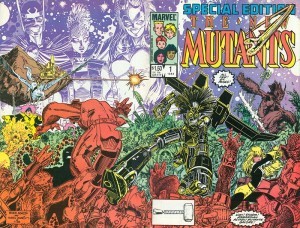 Taking characters out of their element can yield great results when executed properly. And New Mutants Special #1 nails it.
Taking characters out of their element can yield great results when executed properly. And New Mutants Special #1 nails it.
The X-Men have had many spinoffs over the years, but the New Mutants were the first “second” team of mutant characters at Xavier’s School for Gifted Youngsters. And they were meant to be students first and foremost, not superheroes. These were young teenagers learning to control their powers in a world that fears and hates them.
So this story scatters them across an entirely different world…Asgard. Yes—Thor’s Asgard, the mythical Norse realm full of gods and goddesses. In this extra-sized special, writer Chris Claremont gives each individual New Mutant ample focus as they’re separated across different regions of this fantastical realm full of creatures and characters they never expected to meet. Some of the mutants initially enjoy the experience while others find themselves in troublesome predicaments, but strong characterization drives everything.
And Arthur Adams’s pencils and layouts provide a suitably epic feel to the proceedings. The book is a treat to both look at and read.
This was a special that earned the label. Classic stuff. My favorite New Mutants story.
Writer: Chris Claremont
Penciler: Arthur Adams
Inker: Terry Austin
Publisher: Marvel
How to Read It: back issues; Marvel Unlimited; included in X-Men: The Asgardian Wars (TPB)
Appropriate For: ages 10 and up
May 17, 2016
Today’s Super Comic: Invincible Iron Man #3 (2015)
Every day for the next year, I will briefly review one comic book – but only the good books. Sometimes individual issues, sometimes full storylines or trade paperbacks. Sometimes recent offerings, sometimes old. But all will be worth checking out. For the benefit of parents, I’ll recommend what ages the book is appropriate for. I won’t bother giving a star or letter-grade rating. If it’s included, it’s at least a B+ book. So whether you’re a casual comics read, a serious fan who may have missed something, or the parent of a young reader trying to navigate this crazy world, hopefully you’ll pick up some good tips over the next 365 days. And these will be free of major spoilers.
So, the Marvel Cinematic Universe managed pretty well by starting off with Iron Man, so I’ll go with that…
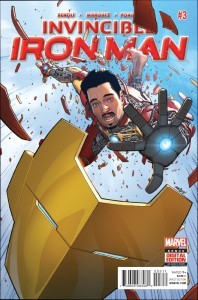 Iron Man and Doctor Strange bond over their facial hair. This was long overdue.
Iron Man and Doctor Strange bond over their facial hair. This was long overdue.
Brian Michael Bendis has been one of the most reliable writers in the industry for over 15 years now, and he’s not losing any steam. He perfectly captures Tony Stark’s voice; the Robert Downey Jr. influence is on display here and an excellent match for Bendis’s talky style. The conversation between Stark and new romantic interest Amara Perera is fantastic and ends with a terrific punchline.
David Marquez’s art also suits the book exceptionally well. He draws expressive characters and kinetic action. Whether people are talking or fighting, the book moves.
The storyline involves two classic villains—Madame Masque and Doctor Doom—and magic, which will no doubt pull Iron Man out of his element in entertaining fashion as events unfold.
This is a comic that knows how to have fun, and I’m looking forward to the next issue hitting the Marvel Unlimited library. (Marvel Unlimited lags several months behind the direct sales editions.) If they keep this quality up, I might even spring for the trades or floppies.
Writer: Brian Michael Bendis
Artist: David Marquez
Publisher: Marvel
How to Read It: Recent back issue; Marvel Unlimited; included in Invincible Iron Man Vol. 1: Reboot (HC)
Appropriate For: 13 and up
May 12, 2016
Avenging The Fantastic, Part 12: Meet the Falcon…And His Falcon!
Continuing the read-through of as many Avengers and Fantastic Four–related Marvel comics as possible!
Books Read
Avengers #64-72; Fantastic Four #82-93; Thor #160-171; Incredible Hulk #116-124; Captain America #114-119; Captain Marvel #15-19; Iron Man #15-20; years: 1969-70.
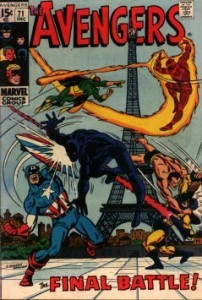 The Revolving Door of Avengers Mansion
The Revolving Door of Avengers Mansion
Captain America, Iron Man, and Thor are back in action…at least part of the time. And the Black Knight becomes an official Avenger though not an active one, as he resides in England, which would be quite the commute.
The Dawn of the ‘70s
As this read-through finally hits the 1970s, and after we’ve all been subjected to the super-serious monstrosity known as Batman v. Superman: Dawn of Justice, let’s appreciate how nice and innocent these old comics are. True, they are infected with the prejudices of their era (i.e. no shortage of sexism), but otherwise they depict many fine role models for the children who were reading them back in the day. These characters always try to do the right thing and make their world a better place. In the Marvel Comics Universe, superheroes err, but they tend to find their way back on track.
In DC’s rush to copy the success of the Marvel Cinematic Universe, and establish a different tone from the MCU, they’ve given us a Superman who’s not very heroic and a Batman who’s willing to indirectly kill criminals, and that’s a loss for today’s kids. Adults can enjoy superheroes, too (as I certainly do), but we shouldn’t take the classics away from children.
These comics, for all their faults, depict superheroes as originally intended, in colorful, action-packed stories that excite the imagination and encourage us to be the best that we can be. But enough with the soapbox—on to the comics!
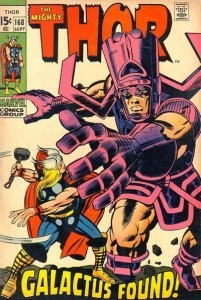 The History of Galactus – Thor #160-161, 168-169
The History of Galactus – Thor #160-161, 168-169
Some stories can only be told in the comic book medium—stories such as a big world-eating guy fighting a sentient planet. Galactus squares off against Ego the Living Planet, with Thor and others caught in the middle, and it’s epic indeed. Totally ridiculous, yes, and no other medium could do it justice, but it works wonderfully as an action-packed comic.
The fight puts Galactus on Odin’s radar, so shortly later he sends Thor to find and battle Galactus. But since we’ve just had a world-shattering Galactus fight, Stan Lee and Jack Kirby give us something different—the origin of Galactus. Turns out, Galactus is tired of fighting, and he just wants to tell Thor how he came to be. Why now and why to Thor? Because he’s Galactus, and his prodigious mind is such that we cannot comprehend, so don’t question anything that seems convenient or coincidental.
Anyway, Galactus is the sole survivor of his planet, Taa. Weird radiation happened. The Watcher observed it all and was tempted to stop this destructive being from coming into existence, but ultimately the Watcher takes his watching seriously. So if countless planets need to get eaten, fine, so long as the Watcher never interferes. Again, it would probably make sense to minds less mortal than ours.
And once Galactus tells his tales, Odin abruptly recalls Thor, and sadly no Thor vs. Galactus duel occurs. Maybe later? We shall see. But some credit is due for attempting to make Galactus an actual character rather than a force of nature. It wasn’t essential, as Galactus has always been a different sort of threat from your standard Doctor Doom or Loki, but we’ll see if it pays off in a later story. That’s how comic work best—plant some seeds without a concrete game plan, and a few years later realize the potential…hopefully.
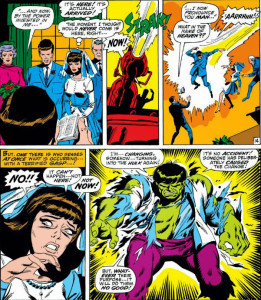 No Happiness for the Hulk – Incredible Hulk #122-124
No Happiness for the Hulk – Incredible Hulk #122-124
With the help of the Fantastic Four, Bruce Banner takes control of his Hulkish transformations and figures out how to retain his intellect while big and green. But understandably, he wants to leave the Hulk behind and lead a normal life with Betty Ross. He pops the question, and they enjoy peaceful moments and get as far as their wedding ceremony. In typical Marvel fashion, however, super-villains intrude. The Leader and Rhino strike at their wedding and force Banner’s transformation into the savage Hulk, undoing all progress made…and before the “I do’s,” no less. And General Ross gets seriously wounded in the scuffle, so a Hulk battle results in an actual consequences, which is a nice change of pace (though perhaps not for the general).
Far from perfect, but a definite improvement. Credit goes to new writer Roy Thomas, as well as artist Herb Trimpe for loosening up the layouts a bit. More credit would go to them if they worked on making Betty an actual character rather than a goal.
The Falcon Fights! – Captain America #117-119
In the film Captain America: The Winter Soldier, Cap meets Sam Wilson a.k.a. the Falcon during a pleasant jog in Washington, D.C. In the comics, Cap meets Sam on a small island while the former is trapped in the Red Skull’s body. Sam doesn’t even realize he’s met Cap until #119. So, slight differences there.
Comics Falcon has an actual falcon for a sidekick. The bird’s name is Redwing (you may have noticed a machine of the same name in Captain America: Civil War), and they share a special, inexplicable bond that allows Redwing to do Falcon’s bidding. At this point, the Falcon merely has his bird and some fighting skills Captain America taught him in a crash course. His wings will come later. And he is officially Marvel’s first African American superhero (the Black Panther isn’t American).
“Me? A costumed clown? Don’t put me on, man!” –Sam Wilson, Captain America #117
Side note: Cap also spent #116 stuck in the Skull’s body, and he spent the whole issue being chased by the authorities and Avengers. Only after all that does he realize, hey, the Skull’s red skull is just a mask! Just take it off, and he’s unrecognizable! Silly Cap…not realizing you’re wearing a mask for a whole issue!
Captain Marvel Reborn! – Captain Marvel #17-18
So if you’ve got an unlikeable alien superhero and an annoying perennial teen sidekick, what do you with them? How do you solve a couple of problems like Captain Marvel and Rick Jones? Easy—combine them into the same person! Sort of.
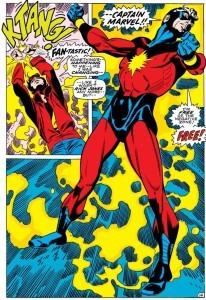 Weird cosmic stuff happens to Captain Marvel, trapping him in the Negative Zone (the place Reed Richards discovered a while back). So the powers-that-be lure Rick Jones to these things called nega-bands. Now, Rick has been having a rough time lately. He had a brief stint trying to succeed the late Bucky Barnes as Captain America’s sidekick, but then Cap inexplicably rebuffs him. Well, not inexplicably—the explanation is that the Red Skull had taken up residence in Cap’s body and didn’t want a meddling teenager around. But Rick just figures Cap has become a jerk, so he runs off on his own. Ever the impressionable sidekick, though, he’s susceptible to being lured toward alien armbands.
Weird cosmic stuff happens to Captain Marvel, trapping him in the Negative Zone (the place Reed Richards discovered a while back). So the powers-that-be lure Rick Jones to these things called nega-bands. Now, Rick has been having a rough time lately. He had a brief stint trying to succeed the late Bucky Barnes as Captain America’s sidekick, but then Cap inexplicably rebuffs him. Well, not inexplicably—the explanation is that the Red Skull had taken up residence in Cap’s body and didn’t want a meddling teenager around. But Rick just figures Cap has become a jerk, so he runs off on his own. Ever the impressionable sidekick, though, he’s susceptible to being lured toward alien armbands.
By donning the nega-bands and slamming them together, he switches places with Captain Marvel. CM gets to play superhero on Earth, and Rick is shunted to the Negative Zone, where he gets to float around with a bunch of debris. Slam them together again, and they switch again. In either form, these two fellows can communicate with each other. It’s similar, though not identical, to DC’s Firestorm, who has appeared and currently appears on the CW’s Flash and Legends of Tomorrow TV series. Firestorm is two very different dudes inhabiting the same form and sharing a telepathic link. This iteration of Captain Marvel predates Firestorm, but it also loosely resembles the very first Captain Marvel introduced by Fawcett Comics in the 1940s (and later acquired by DC). That “Shazam” version of Captain Marvel also features an ordinary kid who gets to transform into an adult superhero.
With #18, after one last stint as damsel in distress, future Captain Marvel Carol Danvers leaves as a regular supporting character, so I’ll quit this title. Frankly, it’s not holding my attention. But to leave it on a positive note, legendary comics artist Gil Kane takes over the penciling duties and his dynamic layouts truly do elevate the quality.
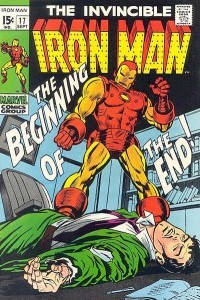 The Best of This Bunch – Iron Man #17-18
The Best of This Bunch – Iron Man #17-18
Iron Man takes on a classic sci-fi trope—the invention rising up to replace the inventor. In an earlier issue, he had made use of a Life Model Decoy (LMD) to help preserve his secret identity, but a freak accident causes the robot to come to life…and this time, it possesses the ambition to become Tony Stark and Iron Man in the eyes of the world. It has his exact looks, all his knowledge, and none of his heart troubles, and it easily convinces people that the real Stark is actually the imposter. In order to get his life back, Stark has to resort to working with new villain Madame Masque.
We’ve previously met Madame Masque as Whitney Frost (recently seen in season two of Agent Carter), but now her face is hideously scarred, so she hides behind a mask, Doctor Doom–style. But unlike that of Doctor Doom, her heart is capable of melting under the charms of one Anthony Stark. And he’s attracted to her. It’s all very Batman/Catwoman, but with a heart condition and catastrophic skin damage—the Marvel way!
These two issues culminate in an Iron Man vs. Iron Man battle, with Tony donning his original, less sophisticated armor to fight the tireless LMD. And the victory is not without a cost.
At long last, Iron Man’s solo series starts getting engaging, thanks to Archie Goodwin—the late, great comics writer who’s just beginning to realize his potential in this early stage of his career.
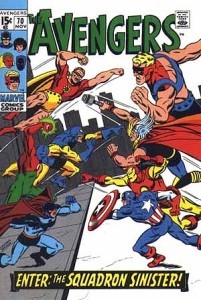 The Avengers vs. the Justice League? – Avengers #70-71
The Avengers vs. the Justice League? – Avengers #70-71
Not quite, but they do fight a group of DC Comics analogues called the Squadron Sinister—Hyperion (Superman), Nighthawk (Batman), Dr. Spectrum (Green Lantern), and the Whizzer (Flash).
Kang and some new immortal being called the Grand-Master set up a contest of champions, with the fate of the world naturally in the balance. The plot is merely an excuse for the action. Issue #70 pits Captain America, Thor, Iron Man, and Goliath against the faux Justice League, and #71 pits Black Panther, Yellowjacket, and Vision against Marvel’s most popular 1940s heroes in 1940—Captain America, Namor the Sub-Mariner, and the original Human Torch.
Utterly brainless, and it’s not character-driven like Captain America: Civil War is, but it has a certain old-school charm to it and doesn’t take itself too seriously.
Meanwhile…
–In Avengers #64, Egghead destroys a small Midwestern town…but only after he gives the residents fair warning to evacuate. Super-villains were so much nicer back in the day, weren’t they?
–In the same issue, Hawkeye (now the second Goliath) finally gets a real name. Two-bit criminal Barney Barton comes to the Avengers’ aid, and after the guest star’s sudden but inevitable death, we learn his brother is Hawkeye, a.k.a. Clint Barton.
–“…And to help me choose a name for you! The more I think about it, the more confused I grow! But Reed is so good at things like this!” –Sue Richards, positively befuddled at the prospect of naming her own son.
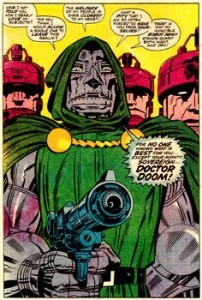 –“The welfare of my people is ever closest to my heart! What a pity that I am so often forced to save you from yourselves! … No one knows what is best for you…except your mighty sovereign…Doctor Doom!” –Doctor Doom, FF #84. And he believes it, too. Marvel’s portrayal of women may have been lacking, but the writers had a firm grasp of egocentric dictators.
–“The welfare of my people is ever closest to my heart! What a pity that I am so often forced to save you from yourselves! … No one knows what is best for you…except your mighty sovereign…Doctor Doom!” –Doctor Doom, FF #84. And he believes it, too. Marvel’s portrayal of women may have been lacking, but the writers had a firm grasp of egocentric dictators.
–“Every girl can be domestic, Johnny…when it matters!” –Sue Richards, FF #88. Yeah, women were not the company’s strong suit.
–In Captain America #114, Cap insists that his girlfriend Sharon Carter quit SHIELD…because it’s too dangerous for her! Sometimes it’s like Cap never left the 1940s. But credit where due: Sharon does not yield to his demands. (Movie Cap never insisted Peggy Carter return to civilian life. Movie Cap is the better man, it seems.)
–The super-metal adamantium is introduced in Avengers #66. Today, this indestructible substance is most commonly associated with Wolverine, as the stuff coats and protects his bones, but Wolverine’s introduction is still years off at this point. Originally, Ultron built himself a new robotic body composed entirely of adamantium, making him an indestructible nemesis for the Avengers. So Ultron wore it first, but who wore it better?
To Be Continued…
The Black Widow gets her own series for like two whole seconds! Well, she shares a title with the Inhumans, but it’s her own half of the book!



